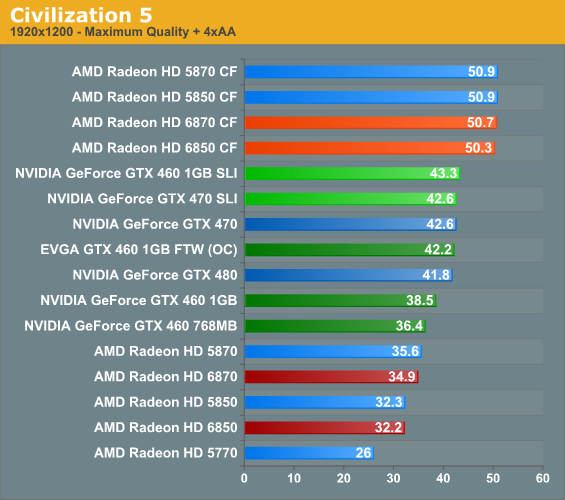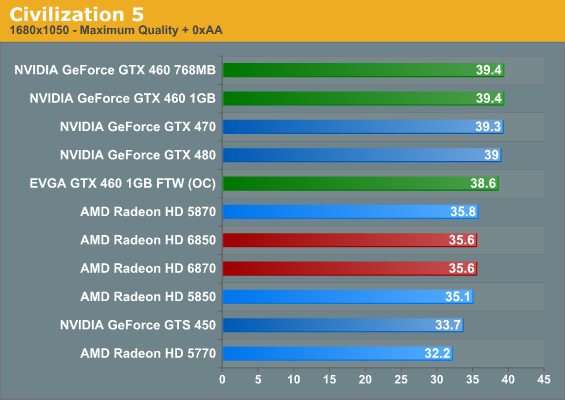AMD’s Radeon HD 6870 & 6850: Renewing Competition in the Mid-Range Market
by Ryan Smith on October 21, 2010 10:08 PM ESTThe last new game in our benchmark suite is Civilization 5, the latest incarnation in Firaxis Games’ series of turn-based strategy games. Civ 5 gives us an interesting look at things that not even RTSes can match, with a much weaker focus on shading in the game world, and a much greater focus on creating the geometry needed to bring such a world to life. In doing so it uses a slew of DirectX 11 technologies, including tessellation for said geometry and compute shaders for on-the-fly texture decompression.
It’s also one of the few games banned at AnandTech, as “one more turn” and article deadlines are rarely compatible.



Civ 5 has given us benchmark results that quite honestly we have yet to fully appreciate. A tight clustering of results would normally indicate that we’re CPU bound, but the multi-GPU results – particularly for the AMD cards – turns this concept on its head by improving performance by 47% anyhow. The most telling results however are found in the GTX 460 cards, where there’s a clear jump in performance going form the 768MB card to the 1GB card, and again from the 1GB card to the EVGA card. The 1GB GTX only improves on memory, memory bandwidth, and ROPs, greatly narrowing down the factors. No one factor can explain our results, but we believe we’re almost simultaneously memory and geometry bound.
With that in mind, this is clearly a game that benefits NVIDIA’s GPUs right now when we’re looking at single-GPU performance. This likely comes down to NVIDIA’s greater geometry capabilities, but we’re not willing to rule out drivers quite yet, particularly when a partially CPU-bound game comes in to play. In any case NVIDIA’s advantage leads to their wiping the floor with AMD here, as even the mere GTX 460 768MB can best a 5870, let alone the 6800 series.
Crossfire changes things up, but only because NVIDIA apparently does not have a SLI profile for Civ 5 at this time.










197 Comments
View All Comments
Ryan Smith - Friday, October 22, 2010 - link
Quality is unchanged. UVD 3 adds a few fixed function blocks, but quality is a matter of post-processing and hence affected by the drivers once you have sufficient shader power to do all the post-processing.Pastuch - Friday, October 22, 2010 - link
I posted about this earlier but my post was deleted.Ryan there is a ton of HTPC users on this site.
1. Exactly how long is the Radeon 6870/6850 vs the GTX 460?
2. How does the GTX460 compare to the Radeon 6 series regarding bitstreaming high def audio?
3. How UVD3 post-processing compare to Nvidias?
Ryan Smith - Friday, October 22, 2010 - link
It's exactly the same as this: http://www.anandtech.com/show/3973/nvidias-geforce...HigherGround - Friday, October 22, 2010 - link
Why was EVGA card included in this test? The rest of the field is generic (non OC, no brand), so why included an OC card, which skews the readers perspective? Pretty sure EVGA paid you to included its top OC card in this review ...Parhel - Friday, October 22, 2010 - link
No, NVidia paid them to include it. NVidia sends "guidelines" to all the hardware review sites, telling them what settings to use and which cards to use in the comparison. In the guidelines for today's review was to use the EVGA GTX 460 FTW, and and site you see using it is essentially a paid NVidia shill.I could care less about ATI vs NVidia, as I'm not really a gamer, but I'm very disappointed today to see my long time favorite hardware site stooping to this level. In the end, it gives consumers bad information, which should be antithetical to the purpose of a site like this.
AtwaterFS - Friday, October 22, 2010 - link
I agree, this site is typically class-leading, but this article give AnandTech a bit of a black eye and the results dont particularly jive with "un-biased" sites like HardOCP.DrKlahn - Friday, October 22, 2010 - link
I was going to post the same thing. As a long time reader of this site, I was very disappointed with the decision to include the overclocked card. Either the ATI cards should have been overclocked and their results provided in every test or it should have been excluded as per the normal benchmarking guidelines.I would have no issue with a followup or side article comparing factory overclocked offerings. But this is clearly bowing to pressure from Nvidia and I expected better of this site.
aungee - Saturday, October 23, 2010 - link
To Include the EVGA GTX 460 FTW was unfair and whether intentional or not it did spoil the launch party for AMD on this site to some degree. It would have been more appropriate to make a small mention of it's existence and to benchmark it in the future against any factory OC 6800 cards.After getting your head around the naming, AMD needs to be credited for bringing such a performance on only a 255 mm2 package (it even caused the price drop for the 530mm2 GTX 470) . AMD has headroom to drop the price of the 6800 cards so lets hope they do soon.
tigersty1e - Friday, October 22, 2010 - link
I couldn't find the clocks, but if you do include an OC'd card in your benches, you should give us the clocks.dertechie - Friday, October 22, 2010 - link
850 MHz Core, 1700 MHz shaders, 4 GHz Memory, up from 675 MHz Core, 1350 MHz shaders, 3.6 GHz Memory.That's a 26% Core OC and an 11% Memory OC. However, the cost has been OC'd too, the FTW card costs the same $240 as the stock Radeon 6870.